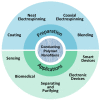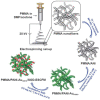Electrospun Conducting Polymers: Approaches and Applications
- PMID: 36556626
- PMCID: PMC9782039
- DOI: 10.3390/ma15248820
Electrospun Conducting Polymers: Approaches and Applications
Abstract
Inherently conductive polymers (CPs) can generally be switched between two or more stable oxidation states, giving rise to changes in properties including conductivity, color, and volume. The ability to prepare CP nanofibers could lead to applications including water purification, sensors, separations, nerve regeneration, wound healing, wearable electronic devices, and flexible energy storage. Electrospinning is a relatively inexpensive, simple process that is used to produce polymer nanofibers from solution. The nanofibers have many desirable qualities including high surface area per unit mass, high porosity, and low weight. Unfortunately, the low molecular weight and rigid rod nature of most CPs cannot yield enough chain entanglement for electrospinning, instead yielding polymer nanoparticles via an electrospraying process. Common workarounds include co-extruding with an insulating carrier polymer, coaxial electrospinning, and coating insulating electrospun polymer nanofibers with CPs. This review explores the benefits and drawbacks of these methods, as well as the use of these materials in sensing, biomedical, electronic, separation, purification, and energy conversion and storage applications.
Keywords: conducting polymers; electrospinning; nanocomposite; nanofibers.
Conflict of interest statement
The authors declare no conflict of interest.
Figures


























References
-
- Yanilmaz M., Sarac A.S. A review: Effect of conductive polymers on the conductivities of electrospun mats. Text. Res. J. 2014;84:1325–1342. doi: 10.1177/0040517513495943. - DOI
Publication types
Grants and funding
LinkOut - more resources
Full Text Sources
Miscellaneous

